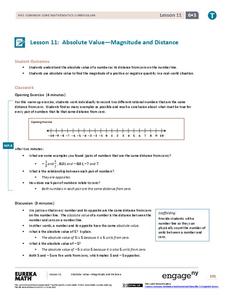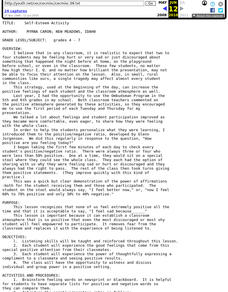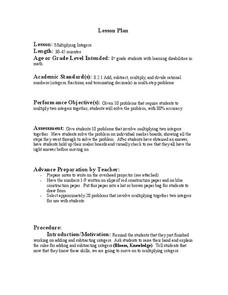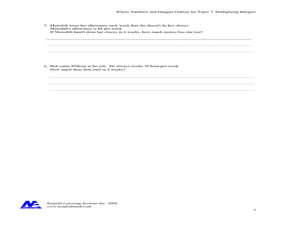Alabama Learning Exchange
Exponents and Division
Create a human fraction to learn about division of exponents. Scholars develop the rule for division of exponents by being part of a human fraction to explore and justify the rule. They also consider zero exponents and negative exponents.
Virginia Department of Education
The Modern Model of Atomic Structure
The difference between atomic mass and atomic number can be confusing for some young chemists. Help your class better understand the concepts by allowing them to sketch an atom on paper and then discuss their experience. Upon completion...
EngageNY
Absolute Value—Magnitude and Distance
Do you want to use the resource? Absolutely. Scholars learn about absolute value and its relation to magnitude and distance on a number line. They compare numbers in context by applying absolute value.
EngageNY
Efficacy of Scientific Notation
How many times could California fit into the entire United States? Pupils use scientific notation to find the answer to that question in the 12th installment of 15 lessons. It asks scholars to write numbers in scientific notation and...
Curated OER
Self-Esteem Activity
Students create a classroom atmosphere that is so positive that even the most discouraged or most shy student feels empowered to participate. They discuss positive and negative words and internal and external locus of control.
Curated OER
Multiplying Integers
Seventh and eighth graders solve math problems where they multiply positive and negative integers. In this multiplication lesson plan, learners use slate boards to complete problems. The step-by-step plan tells you what to write and say...
Curated OER
Signed Numbers and Order of Operations II
In this signed number worksheet, students find the sum and difference of positive and negative integers. They use the order of operations to solve equations containing exponents and parenthesis. Students complete 26 problems.
Curated OER
Addition With Integers
Eighth graders investigate the concept of combing integers using addition. They begin to comprehend the connection of addition and subtraction. Students also review the concept of positive and negative numbers.
Curated OER
Meter Marker Mania
Students identify integers as rational and irrational numbers. In this algebra instructional activity, students measure and construct number lines using positive and negative integers. They convert between decimals and fractions.
Alabama Learning Exchange
Battle to the Death: Adding Integers
Young scholars explore the concept of adding integers. In this adding integers lesson, students simulate the battle of the 300 spartans at Thermopylae. Young scholars use colored game pieces to represent positive and negative...
Curated OER
Temperature
Students understand that temperatures in Alaska can be negative numbers. In this temperature lesson, students recognize the temperatures above and below zero. Students compare temperatures using the greater than and less than signs....
Curated OER
Introduction to Pre-Algebra
Students explore adding and subtracting positive numbers. Students discuss the use of algebra in our daily lives. They examine the algebraic equations and observe their solutions. Students work on the board and at their desks to solve...
Curated OER
Integer Arithmetic
Students solve integer-based problems. They add and subtract integers as well find missing integers. They represent a scenario involving positive and negative integers and solve it.
Curated OER
Cartesian Coordinates
Students investigate rational numbers through data analysis and statistics. For this algebra lesson, students represent, rename, compare and order rational numbers. They collect and represent data correctly on a graph.
Curated OER
Integer Subtraction
Students examine why a negative number subtracted from another number changes the operation to addition.
Curated OER
Number and Number Relations: Lesson 3
Eighth graders compare whole numbers and decimals. They use symbols for <, >, =, and order whole numbers and decimals. They practice the meaning of positive and nugative integers by using them to describe real-world situations.
Curated OER
The Number Line
Eighth graders investigate the order of numbers and how they are located on the number line. They also review the symbols used to compare quantities in order to decipher simple expressions and graph them on the numberline.
EngageNY
Multiplication of Numbers in Exponential Form
Develop a solid understanding of multiplication and division properties of exponents. Individuals expand exponential terms to discover the patterns and create the properties in the second installment in a series of 15. The activity...
Curated OER
Multiplying Inequalities by Negative
Students multiply inequalities by negative. In this algebra lesson, students solve inequalities and graph their solutions on a number line. They pay close attention to the negative consequence, which causes the sign to flip.
Curated OER
Graphs
In this graph template worksheet, students observe a graph divided in half with numbers from negative zero to five to positive zero to five. Students observe 1 graph.
Curated OER
Fraggle Monster Vase
Students create an optical illusion. For this optical illusions lesson, students sketch a monster's face to create the optical illusion of a vase in the positive space. Students create an original piece of art.
Curated OER
Matter, Matter
Learners define vocabulary related to the parts of the atom. In this matter instructional activity, students navigate the web to find the structure and the forces that affect atoms. Learners complete an experiment with...
Curated OER
Lines of Fit
Students graph an equation and analyze the data. In this algebra instructional activity, students graph scatter plots and identify the line of best fit using positive correlation, negative correlation an d no correlation. They apply...
Neufeld Learning Systems
Concept: Multiplying Integers
A three-page handout provides reinforcement of the rules of multiplying positive and negative integers, as well as practice solving this type of problem. Most useful is the chart early in the assignment where learners fill in a column...























